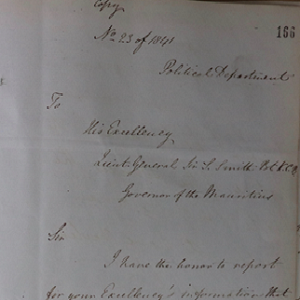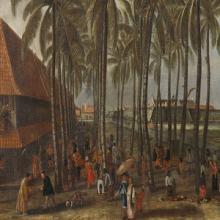Modern (1800 CE - 1950 CE)

Edward Waring on Borax as medicine in India
Waring published the book in several Indian languages and another publication Supplement to the Pharmacopoeia of India, written by Moodeen Sherriff, an Indian doctor working for the colonial administration, provided the translations and medical plant knowledge in 14 different languages.

Edward Waring on Assafœtida as medicine in India
Medical publications appealed to a medical and popular audience in the hopes of providing surgeons with tips on how to obtain similar drugs and medicine in local bazaars which could not be obtained elsewhere.

Short Teaching Module: Global Microhistory and the Nineteenth-Century Omani Empire
In their primer essay, Jessica Hanser and Adam Clulow note how scholars of global microhistory explore relationships between macro and micro, deep structures and contingency, and big state actors and minor players.

1841 Letter from Atkins Hamerton
Atkins Hamerton (d. 1857) was a British military officer and diplomat, who served as the first British Consul to the Omani Empire based in Zanzibar. He left behind thousands of pages of sources, presently scattered between archives in the U.K., Zanzibar, and India.

Memoir of William Ruschenberger
Dr. William Ruschenberger (d. 1895) was a United States Navy surgeon and was assigned to the USS Peacock, serving with Edmund Roberts as part of an American delegation representing the Jackson Administration to negotiate treaties with the Omani Empire and the Kingdom of Siam.

Short Teaching Module: Spatial Histories of Law, Race and Empire
Law is not only to be found in doctrine and documents, but also in structures and materials, in buildings and in cloth, in paintings and in photos.

The landraad in Pati
This is a photo of a mixed colonial law court, the landraad, in Pati, a town located on the island of Java, now part of Indonesia. The photo was made by the British photographers Woodbury & Page on the request of the bupati (regent) Raden Adipati Ario Tjondro Adhi Negoro.

Togo farm families cracking oil palm kernels
This photo was part of a short photo series documenting palm oil production in the German colonies in Africa, included in a report by a special oil commission of the German Colonial Society (Deutsche Kolonialgesellschaft) in 1913.

Ideal ration recipe
This is one page out of a notebook kept by Stephen Robinson Parsons, a somewhat improvement-minded farmer in South Paris, Maine. Around 1896, Stephen copied into his fact book an ideal ration:

Short Teaching Module: Agricultural Knowledge in the Late Nineteenth Century
Knowledge knows no national boundaries. Therefore, the history of knowledge also has to move beyond national boundaries to understand how knowledge was produced, moved, and adapted. Telling such a history without the limitations of national boundaries is challenging.